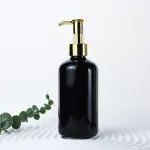Nov. 16, 2023
Packaging & Printing
Sustainable cosmetic packaging has become a focal point for both consumers and manufacturers as environmental consciousness continues to shape consumer preferences. The choice between glass bottles and plastic for cosmetic packaging involves a careful consideration of various factors, including environmental impact, recyclability, aesthetics, and product protection. Each material has its merits and drawbacks, and the decision ultimately depends on the specific goals and values of the brand in question.
Environmental Impact:
Glass Cosmetic Bottles: Glass is often lauded for its eco-friendly attributes. It is 100% recyclable without any loss of quality, and the recycling process can be repeated indefinitely. Additionally, glass is made from abundant and natural raw materials, such as sand, soda ash, and limestone. While the manufacturing of glass bottles does require energy, advancements in production technology have reduced the environmental footprint.
Plastic Bottles: Plastic, on the other hand, has a more complex environmental profile. Although plastic bottles can be recycled, the process is not as straightforward as with glass. Different types of plastics exist, and not all are easily recyclable. Additionally, plastic production relies heavily on fossil fuels, contributing to carbon emissions. While efforts are being made to increase the use of recycled plastics and develop biodegradable alternatives, the environmental impact of plastic remains a concern.
Recyclability:
Glass Bottles: Glass is infinitely recyclable, meaning it can be recycled repeatedly without losing its quality. Glass recycling helps reduce the demand for new raw materials and lowers energy consumption in the manufacturing process.

Plastic Bottles: Recycling plastic bottles is more challenging due to the various types of plastics and the need for separate recycling streams. While progress has been made in recycling technology, there are still limitations, and a significant portion of plastic packaging ends up in landfills or the ocean.
Aesthetics:
Related links:Glass Bottles: Glass exudes a premium and elegant aesthetic that is often associated with high-end products. The transparency of glass allows consumers to see the product inside, enhancing the visual appeal.
Plastic Bottles: Plastic can be molded into various shapes and sizes, offering flexibility in design. However, it may be perceived as less luxurious compared to glass in certain markets.
Product Protection:
Glass Bottles: Glass provides an excellent barrier against external elements such as light and air, making it ideal for products sensitive to these factors. It helps preserve the integrity of formulations, particularly in cosmetics where exposure can degrade the quality of the product.
Plastic Bottles: While advancements have been made in creating barrier properties for plastics, they may not offer the same level of protection as glass. Plastic containers are more permeable to gases and may require additional layers or treatments to safeguard the product.
Conclusion:
The choice between glass and plastic for sustainable cosmetic packaging involves a trade-off between various factors. Glass stands out for its recyclability, premium aesthetics, and superior product protection. However, plastic offers flexibility in design and weight, potentially reducing transportation-related carbon emissions. Ultimately, the decision should align with a brand's commitment to sustainability, considering the entire lifecycle of the packaging material and its impact on the environment. As consumer awareness grows, the beauty industry continues to explore innovative solutions that balance both environmental responsibility and product appeal.
Previous: Does anti-fog film work?
Next: The Versatile Glass Dropper Bottle: A Vessel of Precision and Elegance
Related Articles
If you are interested in sending in a Guest Blogger Submission,welcome to write for us!
All Comments ( 0 )